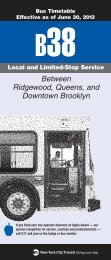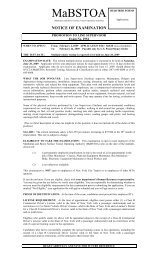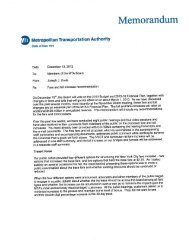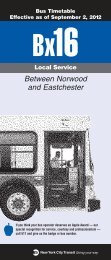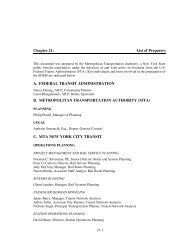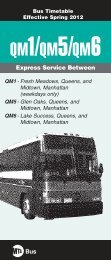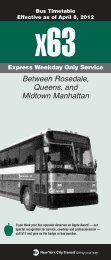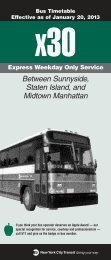Greening Mass Transit & Metro Regions: The Final Report - MTA
Greening Mass Transit & Metro Regions: The Final Report - MTA
Greening Mass Transit & Metro Regions: The Final Report - MTA
You also want an ePaper? Increase the reach of your titles
YUMPU automatically turns print PDFs into web optimized ePapers that Google loves.
8<br />
Why <strong>Greening</strong> the <strong>MTA</strong> Makes Economic Sense<br />
David Lewis, Senior VP, National Director, Economics and Financial Services, HDR Inc.<br />
<strong>The</strong> policies and strategies proposed in this report will do<br />
more than achieve transit and climate-stabilization targets.<br />
<strong>The</strong>y will also have far-reaching implications for the New<br />
York metropolitan region’s short-term and long-term economic<br />
performance. Whether implemented singly or collectively,<br />
these recommendations have the potential to generate<br />
significant returns on investment, with benefits far outweighing<br />
costs.<br />
Equally important, these initiatives augur a new investment<br />
and operating philosophy for the <strong>MTA</strong>, one that will serve<br />
as a forward-looking model for other organizations. <strong>The</strong><br />
reality is that all enterprises today, public and private alike,<br />
must begin to account for the real costs of carbon-based<br />
technologies and the resulting CO2 emissions. This is no<br />
longer a matter of choice. Governments around the world<br />
are ramping up carbon taxes, cap-and-trade systems, and<br />
other policies designed to generate market signals that<br />
compel enterprises to account for climate and pollution<br />
costs as they would for any other investment and operating<br />
decision. <strong>The</strong> initiatives in this report will align the <strong>MTA</strong>’s<br />
decision-making and business practices with this rapidly<br />
emerging market reality.<br />
<strong>The</strong> current financial crisis gives these recommendations<br />
an even more immediate economic relevance. <strong>The</strong> crisis<br />
is widely viewed as a unique opportunity to frame stimulus<br />
actions in a way that will redirect public investment over<br />
the long term. Such redirection focuses on three longstanding<br />
concerns: climate change; energy security;<br />
and infrastructure renewal and expansion. All three of<br />
these priorities argue for expanded investment in transit.<br />
In other words, a transit system such as the <strong>MTA</strong> stands<br />
dead center at the stimulus sweet spot. 3<br />
Moreover, the <strong>MTA</strong> system stands as a model for other<br />
metropolitan regions as they adapt to a changing economy –<br />
an economy that will pay higher dividends for energy<br />
efficiency and dense concentrations of intellectual capital.<br />
With a third of all U.S. transit ridership, the <strong>MTA</strong> region is<br />
by far the most transit-oriented area in the country and –<br />
not coincidently – one of the most energy-efficient and<br />
economically productive. Of the nation’s 100 largest metro<br />
regions, it has the lowest transportation carbon emissions<br />
per capita. Compared to the average American, residents<br />
of the <strong>MTA</strong> region produce 43 percent less CO2 emissions<br />
and, thanks to the density of high-value services, enjoy a<br />
per capita GDP that is 30 percent higher than the average<br />
for U.S. metro areas. Similarly, in other U.S. cities, high<br />
levels of productivity tend to correlate with high levels of<br />
transit service. 4<br />
Rising energy costs and the pricing of CO2 emissions will<br />
only elevate the value of the <strong>MTA</strong> transit network as a<br />
model for other metropolitan areas. To sustain this value<br />
and the New York area’s leadership role, the <strong>MTA</strong> must<br />
keep pace with the other major global transit systems that<br />
are now rapidly modernizing and expanding for economic<br />
advantage. <strong>The</strong> importance of making this investment<br />
sooner rather than later should be a common concern of<br />
all commuters, businesses, citizens, and local governments<br />
that rely on <strong>MTA</strong> services and shape the context in which<br />
the <strong>MTA</strong> system operates.<br />
<strong>Transit</strong>’s Four Green Economic Impacts<br />
According to the recently published Stern Review, 5 failure<br />
to enact deep reductions in greenhouse gasses (GHGs)<br />
will result in overall costs from climate change equal to the<br />
loss of between 5 percent and 20 percent of global GDP,<br />
now and forever. This provides a dramatic example of the<br />
deeper connection between environmental sustainability<br />
and economic viability. As this Commission’s report makes<br />
clear, transit helps gains in productivity and sustainability to<br />
rise in tandem. An expanding transit system not only lowers<br />
carbon emissions, it raises property values. It not only<br />
reduces oil consumption, it concentrates high-value services<br />
and so forth. Here are four key factors through which transit<br />
leverages environmental and economic gains:<br />
1. Avoiding Carbon Emissions: A regional mode shift<br />
from automobiles to transit yields economic and environmental<br />
benefits at many levels. For example, the CO2<br />
emissions from transit ridership are about one-fifth of those<br />
produced by single occupancy automobiles, as measured<br />
on a per-passenger-mile basis. Thus, in addition to overall<br />
fuel efficiency, the shift from automobiles to transit means<br />
an 80 percent rate of carbon avoidance. Since transportation<br />
accounts for nearly 40 percent of GHG emissions in<br />
the U.S., the greening of the nation’s largest transit system<br />
has significant value, both directly and as an infrastructure<br />
model for other urban areas. As it continues to quantify<br />
its carbon avoidance rates, the <strong>MTA</strong> will also be well<br />
positioned for emerging carbon trade markets and carbonbased<br />
funding criteria.<br />
2. Managing Regional Congestion: <strong>Transit</strong> reduces<br />
traffic congestion, which cost the regional economy some<br />
$13 billion in 2007 alone, according to the Partnership for<br />
3 See, Deutsche Bank Group, Economic Stimulus: <strong>The</strong> Case for “Green” Infrastructure, Energy Security and “Green” Jobs, November 2008.<br />
4 (As cited in), David Lewis and Fred Lawrence Williams, Policy and Planning as Public Choice: <strong>Mass</strong> <strong>Transit</strong> in the United States, Ashgate, 1999.<br />
5 Nicholas Stern, <strong>The</strong> Economics of Climate Change: <strong>The</strong> Stern Review, Cambridge University Press, 2006.<br />
6 Partnership for New York City, Growth or Gridlock, 2006 (HDR|Decision Economics).



